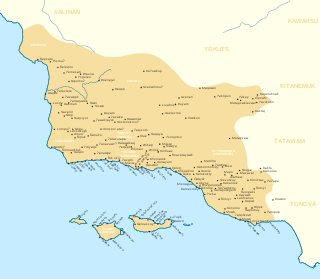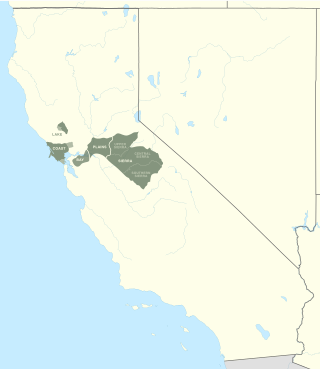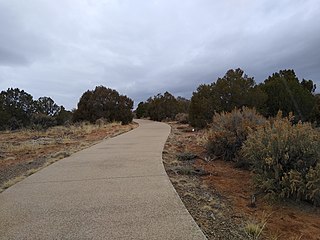
The Chumash are a Native American people of the central and southern coastal regions of California, in portions of what is now Kern, San Luis Obispo, Santa Barbara, Ventura and Los Angeles Counties, extending from Morro Bay in the north to Malibu in the south to Mt Pinos in the east. Their territory includes three of the Channel Islands: Santa Cruz, Santa Rosa, and San Miguel; the smaller island of Anacapa was likely inhabited seasonally due to the lack of a consistent water source.

The Pomo are a Native American people of California. Historical Pomo territory in Northern California was large, bordered by the Pacific Coast to the west, extending inland to Clear Lake, mainly between Cleone and Duncans Point. One small group, the Tceefoka, lived in the vicinity of present-day Stonyford, Colusa County, where they were separated from the majority of Pomo lands by Yuki and Wintuan speakers.

The Miwok are members of four linguistically related Native American groups indigenous to what is now Northern California, who traditionally spoke one of the Miwok languages in the Utian family. The word Miwok means people in the Miwok languages.

The Wintu are Native Americans who live in what is now Northern California. They are part of a loose association of peoples known collectively as the Wintun. There are three major groups that make up the Wintu speaking people: the Wintu, Nomlaki, and Patwin. The Wintu language is part of the Penutian language family.

The Tamástslikt Cultural Institute is a museum and research institute located on the Umatilla Indian Reservation near Pendleton in eastern Oregon. It is the only Native American museum along the Oregon Trail. The institute is dedicated to the culture of the Cayuse, Umatilla, and Walla Walla tribes of Native Americans. The main permanent exhibition of the museum provides a history of the culture of three tribes, and of the reservation itself. The museum also has a second hall for temporary exhibitions of specific types of Native American art, craftwork, history, and folklore related to the tribes.
The Timbisha are a Native American tribe federally recognized as the Death Valley Timbisha Shoshone Band of California. They are known as the Timbisha Shoshone Tribe and are located in south central California, near the Nevada border. As of the 2010 Census the population of the Village was 124. The older members still speak the ancestral language, also called Timbisha.

Hawkins Preserve is a 122-acre (0.49 km2) property within the city limits of Cortez, Colorado. It is protected by a conservation easement held by the Montezuma Land Conservancy.

Loren Me’-lash-ne Bommelyn is a tradition bearer for the Tolowa tribe. He has dedicated himself to preserving the traditional songs, language, and basketry. He is the foremost ceremonial leader of the tribe, and its most prolific basketweaver. Bommelyn is an enrolled member of the federally recognized Tolowa Dee-ni' Nation and was elected as their tribal chairperson.

The Autry Museum of the American West is a museum in Los Angeles, California, dedicated to exploring an inclusive history of the American West. Founded in 1988, the museum presents a wide range of exhibitions and public programs, including lectures, film, theater, festivals, family events, and music, and performs scholarship, research, and educational outreach. It attracts about 150,000 visitors annually.

The Museum of Indian Culture is a 501(c)(3) non-profit organization and educational center in Allentown, Pennsylvania.

The visual arts of the Indigenous peoples of the Americas encompasses the visual artistic practices of the Indigenous peoples of the Americas from ancient times to the present. These include works from South America and North America, which includes Central America and Greenland. The Siberian Yupiit, who have great cultural overlap with Native Alaskan Yupiit, are also included.

The Yosemite Museum is located in Yosemite Valley in Yosemite National Park in California. Founded in 1926 through the efforts of Ansel Franklin Hall, the museum's displays focus on the heritage and culture of the Ahwahnechee people who lived in the valley. The collection also includes both utilitarian and made-for-sale baskets dating from c. 1870 to present and is one of the only existing collections encompassing this depth and time span for any group in California.

The Chase Home Museum of Utah Folk Arts is operated by the Utah Division of Arts & Museums, and has been the permanent home of the Utah State Folk Arts Collection since 1987 and is the only museum in the United States that is dedicated to displaying a state-owned collection of contemporary folk art produced by its residents. It is a venue for Utah's diverse artists and communities to share their folk art including: crafts, music, and dance. In addition to rotating exhibits, annual concerts, and hands-on workshops, the Chase Home Museum houses an archive of fieldwork recordings and photographs that document Utah's folk art and traditional culture. The Chase Home Museum currently has three permanent exhibition galleries and one temporary exhibition gallery.
The Table Mountain Rancheria is a federally recognized tribe of Native American people from the Chukchansi band of Yokuts and the Monache tribe. It is also the tribe's ranchería, located in Fresno County, California.

Indigenous peoples of California, commonly known as Indigenous Californians or Native Californians, are a diverse group of nations and peoples that are indigenous to the geographic area within the current boundaries of California before and after European colonization. There are currently 109 federally recognized tribes in the state and over forty self-identified tribes or tribal bands that have applied for federal recognition. California has the second-largest Native American population in the United States.

The Mid-America All-Indian Center is an American museum dedicated to the history and culture of Native Americans. The museum, which is located along the Arkansas River in the Riverside neighborhood of Wichita, Kansas, is considered the only facility solely dedicated to American Indian culture in the U.S. state of Kansas.
Judith Lowry is a Native American artist. Based in Northern California, she is Maidu and Achomawi and enrolled in the Pit River Tribe. Lowry primarily works in acrylics on canvas.
William Ralganal Benson (1862–1937) was an Eastern Pomo basket maker from California. He and his wife Mary Knight Benson (Pomo) excelled in traditional basket making. Their work can be found in the collections of major museums.
Mary Knight Benson (1877–1930) was a Pomo woman from California who excelled in basket making. Her work is highly collectible and renowned for fine craftsmanship. She and her husband, William Ralganal Benson, partnered in basket weaving, and their work is in public museum collections.

Linda Yamane is an Rumsien Ohlone artist and historian, and has reconstructed and "almost singlehandedly revived" the Rumsien language, Rumsien basket-making methods, and other Rumsien traditions.
















